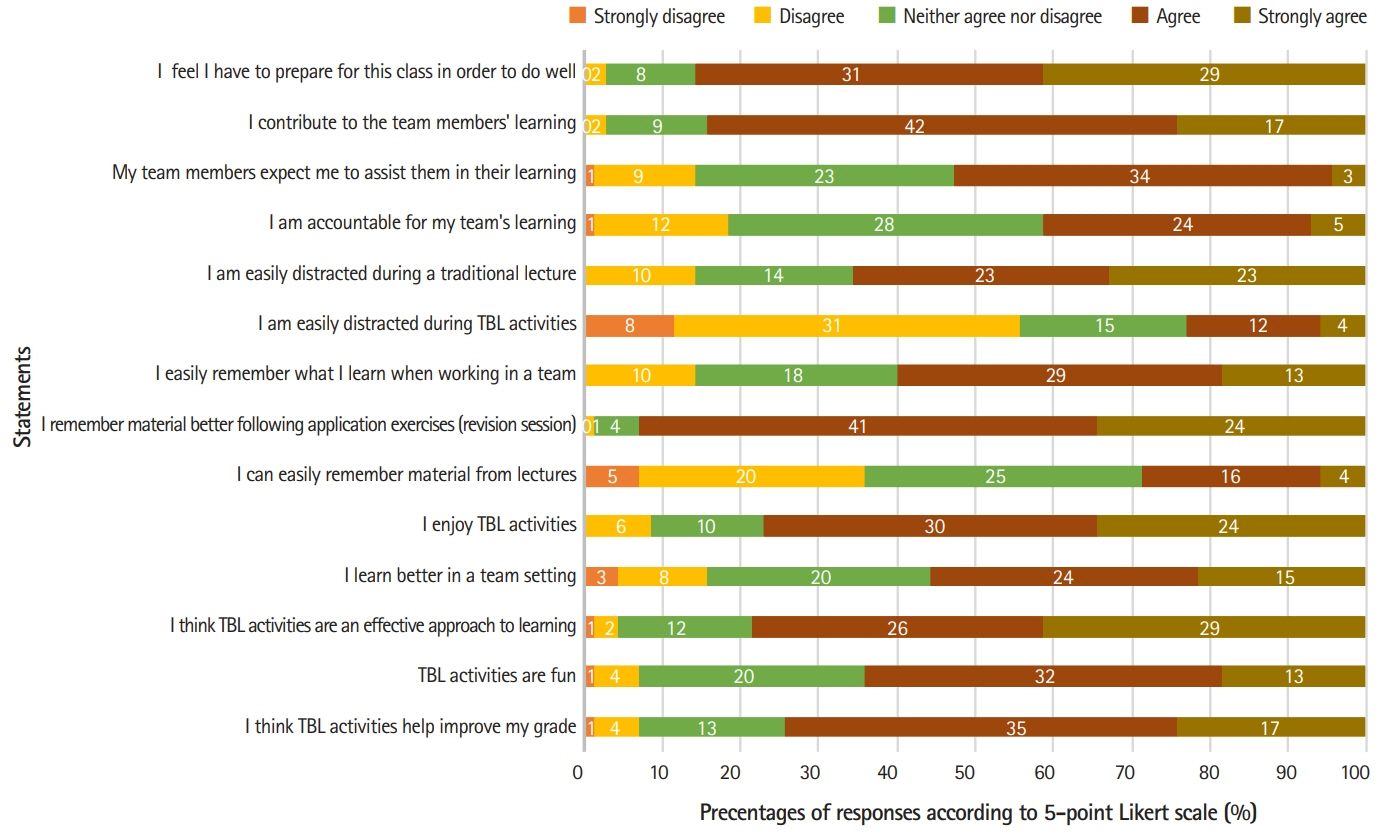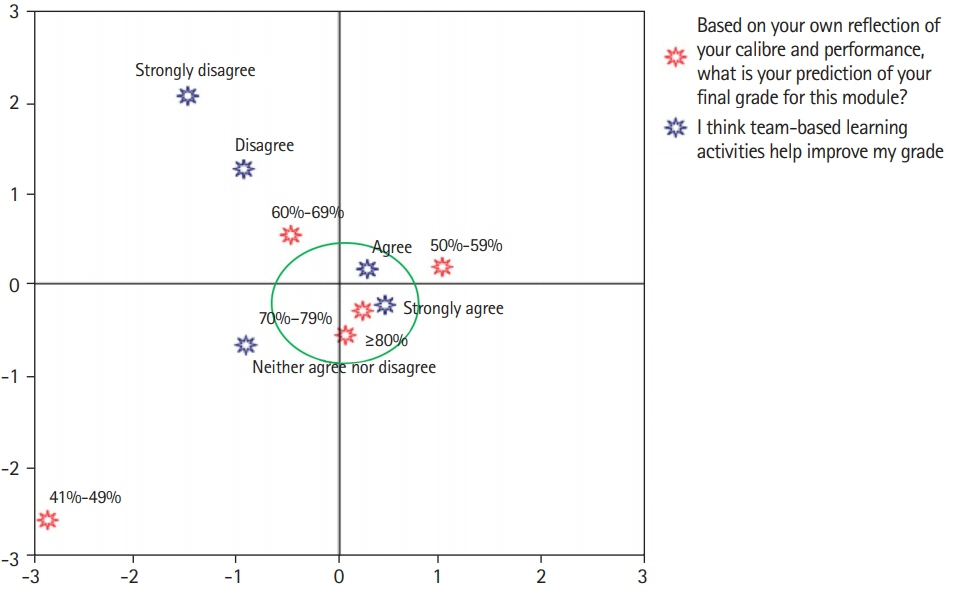J Educ Eval Health Prof.
2019;16:23. 10.3352/jeehp.2019.16.23.
Perceptions of team-based learning using the Team-Based Learning Student Assessment Instrument: an exploratory analysis amongst pharmacy and biomedical students in the United Kingdom
- Affiliations
-
- 1Faculty of Medicine, Imperial College, London, UK
- 2Sussex Pharmacy, School of Life Sciences, University of Sussex, Falmer, UK
- KMID: 2502176
- DOI: http://doi.org/10.3352/jeehp.2019.16.23
Abstract
- Purpose
This study aimed to evaluate students’ perception of team-based learning (TBL) amongst a cohort exposed to this methodology for the first time at a university in the United Kingdom.
Methods
Between November and December 2018, 26 first-year Master of Pharmacy and 90 second-year Biomedical Science students of the School of Life Sciences, University of Sussex, United Kingdom were invited to participate and requested to complete a questionnaire that contained quantitative and qualitative questions. The quantitative component was based on the Team-Based Learning Student Assessment Instrument (TBL-SAI). It additionally contained questions about key student characteristics.
Results
The response rate was 60% (70 of 116); of the participants, 74% (n=52) were females and 26% (n=18) males. The percentage of agreement in the TBL-SAI suggested a favourable response to TBL. The overall mean score for the TBL-SAI was 115.6 (standard deviation, 5.6; maximum score, 140), which was above the threshold of 102, thus suggesting a preference for TBL. Statistically significant differences were not found according to demographic characteristics. Students who predicted a final grade of ≥70% strongly agreed that TBL helped improve their grades. Some students highlighted issues with working in teams, and only 56% of students agreed that they could learn better in a team setting.
Conclusion
This study shows that students exposed to TBL for the first time favoured several aspects of TBL. However, more focused strategies including team-building activities and expert facilitation skills could potentially tackle resistance to working in teams.
Figure
Cited by 1 articles
-
A conceptual model for students’ satisfaction with team-based learning using partial least squares structural equation modelling in a faculty of life sciences, in the United Kingdom
Andrea Manfrin, Bugewa Apampa, Prabha Parthasarathy, Sun Huh
J Educ Eval Health Prof. 2019;16:36. doi: 10.3352/jeehp.2019.16.36.
Reference
-
References
1. Michaelsen LK, Sweet M. The essential elements of team-based learning. New Dir Teach Learn. 2008; (116):7–27. https://doi.org/10.1002/tl.330.
Article2. Reimschisel T, Herring AL, Huang J, Minor TJ. A systematic review of the published literature on team-based learning in health professions education. Med Teach. 2017; 39:1227–1237. https://doi.org/10.1080/0142159X.2017.1340636.
Article3. Branney J, Priego-Hernandez J. A mixed methods evaluation of team-based learning for applied pathophysiology in undergraduate nursing education. Nurse Educ Today. 2018; 61:127–133. https://doi.org/10.1016/j.nedt.2017.11.014.
Article4. Nation LM, Tweddell S, Rutter P. The applicability of a validated team-based learning student assessment instrument to assess United Kingdom pharmacy students’ attitude toward team-based learning. J Educ Eval Health Prof. 2016; 13:30. https://doi.org/10.3352/jeehp.2016.13.30.
Article5. Greetham M, Ippolito K. Instilling collaborative and reflective practice in engineers: using a team-based learning strategy to prepare students for working in project teams. High Educ Pedagog. 2018; 3:510–521. https://doi.org/10.1080/23752696.2018.1468224.
Article6. Mennenga HA. Development and psychometric testing of the Team-Based Learning Student Assessment Instrument. Nurse Educ. 2012; 37:168–172. https://doi.org/10.1097/NNE.0b013e31825a87cc.
Article7. Faul F, Erdfelder E, Lang AG, Buchner A. G*Power 3: a flexible statistical power analysis program for the social, behavioral, and biomedical sciences. Behav Res Methods. 2007; 39:175–191. https://doi.org/10.3758/bf03193146.
Article8. Norman G. Likert scales, levels of measurement and the “laws” of statistics. Adv Health Sci Educ Theory Pract. 2010; 15:625–632. https://doi.org/10.1007/s10459-010-9222-y.
Article9. Jeno LM, Raaheim A, Kristensen SM, Kristensen KD, Hole TN, Haugland MJ, Mæland S. The relative effect of team-based learning on motivation and learning: a self-determination theory rerspective. CBE Life Sci Educ. 2017; 16:ar59. https://doi.org/10.1187/cbe.17-03-0055.
Article10. Sharma A, Janke KK, Larson A, Peter WS. Understanding the early effects of team-based learning on student accountability and engagement using a three session TBL pilot. Curr Pharm Teach Learn. 2017; 9:802–807. https://doi.org/10.1016/j.cptl.2017.05.024.
Article11. Livingston B, Lundy M, Harrington S. Physical therapy students’ perceptions of team-based learning in gross anatomy using the Team-Based Learning Student Assessment Instrument. J Educ Eval Health Prof. 2014; 11:1. https://doi.org/10.3352/jeehp.2014.11.1.
Article12. Parmelee D, Michaelsen LK, Cook S, Hudes PD. Team-based learning: a practical guide: AMEE guide no. 65. Med Teach. 2012; 34:e275–e287. https://doi.org/10.3109/0142159X.2012.651179.
Article13. Vasan NS, DeFouw DO, Compton S. Team-based learning in anatomy: an efficient, effective, and economical strategy. Anat Sci Educ. 2011; 4:333–339. https://doi.org/10.1002/ase.257.
Article14. Obad AS, Peeran AA, Shareef MA, Alsheikh WJ, Kalagi DA, AlAmodi AA, Khan TA, Shaikh AA, Ganguly P, Yaqinuddin A. Assessment of first-year medical students’ perceptions of teaching and learning through team-based learning sessions. Adv Physiol Educ. 2016; 40:536–542. https://doi.org/10.1152/advan.00001.2016.
Article15. Davidson LK. A 3-year experience implementing blended TBL: active instructional methods can shift student attitudes to learning. Med Teach. 2011; 33:750–753. https://doi.org/10.3109/0142159X.2011.558948.
Article
- Full Text Links
- Actions
-
Cited
- CITED
-
- Close
- Share
- Similar articles
-
- The applicability of a validated team-based learning student assessment instrument to assess United Kingdom pharmacy students' attitude toward team-based learning
- Assessment of students' satisfaction with a student-led team-based learning course
- Effects of Blended Learning on Pharmacy Student Learning Satisfaction and Learning Platform Preferences in a Team-based Learning Pharmacy Experiential Course: A Pilot Study
- A conceptual model for students’ satisfaction with team-based learning using partial least squares structural equation modelling in a faculty of life sciences, in the United Kingdom
- Physical therapy students' perceptions of team-based learning in gross anatomy using the Team-Based Learning Student Assessment Instrument



